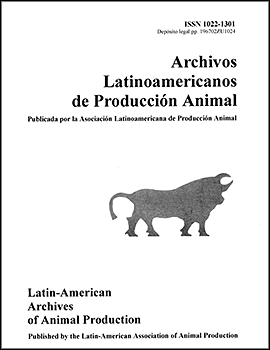
|
Archivos Latinoamericanos de Produccion Animal
Asociacion Latinoamericana de Produccion Animal
ISSN: 1022-1301
EISSN: 1022-1301
Vol. 15, No. S1, 2007, pp. 74-88
|
 Bioline Code: la07035
Bioline Code: la07035
Full paper language: Spanish
Document type: Research Article
Document available free of charge
|
|
|
Archivos Latinoamericanos de Produccion Animal, Vol. 15, No. S1, 2007, pp. 74-88
| es |
Sistemas silvopastoriles como una herramienta para el mejoramiento de la productividad y rehabilitación ecológica de paisajes ganaderos en centro américa
Ibrahim, M.; Villanueva, C. & Casasola, F.
Resumen
El objetivo del presente documento es presentar los
beneficios productivos y ecológicos de los sistemas
silvopastoriles (SSP). Asimismo, mostrar el caso del
proyecto GEF-Silvopastoril en relación al impacto del
pago de servicios ambientales sobre la transformación
de pasturas degradadas a SSP. En Centroamérica los
SSP conspicuos son los árboles dispersos en potrero
y las cercas vivas. La cobertura arbórea en potreros
varía entre 6.8 y 16.5% y el 55% del total de individuos
son representados por menos de 5 especies. La
sombra de los árboles en potrero puede mejorar la
producción de leche y carne en nivel del 15 – 20%,
además, de otros productos arbóreos como madera,
postes, leña, follaje para alimentación animal y frutos.
En la generación de servicios ecológicos, los potreros
con alta cobertura arbórea han mostrado resultados
significativos en la protección del suelo (reduciendo la
erosión), secuestro de carbono y la conservación de la
biodiversidad (en términos de riqueza y abundancia).
Para una mayor adopción de SSP en fincas, es necesario
el uso de incentivos. En este sentido, el proyecto GEF-
Silvopastoril en Costa Rica y Nicaragua por medio del
PSA encontró que los productores en un período de 4
años redujeron las pasturas degradadas en 13 y 20%
del área de la zona piloto en cada país respectivamente;
dicho uso fue transformado principalmente en pasturas
mejoradas con alta densidad de árboles1
(36 y 15%
para cada país respectivamente). Además, las cerca
vivas tuvieron un crecimiento del 63 y 142% para cada
país respectivamente.
Palabras-clave
Cobertura arbórea, pago de servicios ambientales, servicios ecológicos, sombra
|
| |
| en |
Ibrahim, M.; Villanueva, C. & Casasola, F.
Abstract
The aim of the present document is to show the
productive and ecological benefits of the silvopastoral
systems (SPS). Likewise, to show the case of the
GEF-Silvopastoral project in relation to the impact
of the payment of environmental services on the
transformation of degraded pastures to SPS. In
Central America the eminent SPS are the dispersed
trees in pastures and live fences. The tree cover in
pastures changes between 6.8 and 16.5%, and 55 %
of the whole of individuals are represented by less
than 5 species. The shade of the trees in pastures can
improve the production of milk and meat in level of 15
- 20 %. In addition, of other arboreal products as wood,
posts, firewood, foliage and fruit animal feeding. In
the generation of ecological services, the pastureland
with high tree cover has showed significant results
in the soil protection (reducing the erosion), carbon
sequestration and biodiversity conservation (in terms
of richness and abundance). The use of incentives is
keys to promote the adoption of SPS in cattle farms.
In this sense, the GEF – Silvopastoral project in Costa
Rica and Nicaragua by means of the SPS reduced the
degraded pastures in the pilot zone the 13 and 20%
in every country respectively. This use was changed
mainly to improved pastures with high tree density (36
and 15 % for every country respectively). Furthermore,
the live fences had a increasing of 63 and 142% for
each country respectively.
Keywords
Ecological services, payment of environmental services, shade, tree cover.
|
| |
© © Copyright 2007 - ALPA. Arch. Latinoam. Prod. Anim.
Alternative site location: http://www.alpa.org.ve/ojs/index.php
|
|
